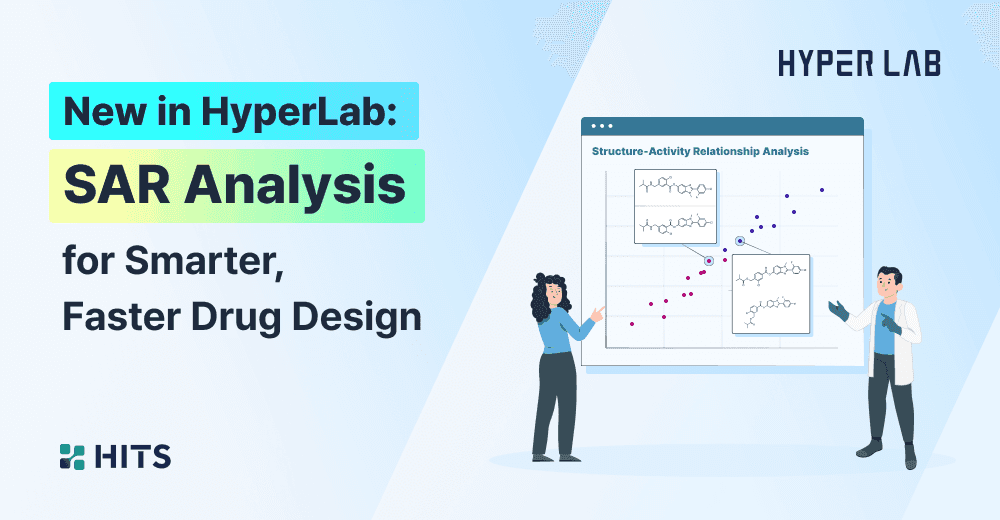New in HyperLab: SAR Analysis for Smarter, Faster Drug Design


Smarter SAR Analysis
For medicinal chemists, SAR (Structure-Activity Relationship) analysis is a critical task in enhancing the efficacy of drug candidate compounds. However, many researchers still rely on manual methods, such as organizing complex molecular structures and comparing or managing data in Excel. This process is not only time-consuming but also prone to errors, significantly hindering work efficiency.
Now, this inefficient analysis process can be dramatically improved with HyperLab, an AI-driven drug development platform. HyperLab provides SAR analysis functions optimized for the actual workflows of medicinal chemists, enabling faster and smarter derivative design and efficacy analysis.
This translation ensures accuracy and aligns with the professional tone of the original text. Since this section appears to be a repeat of the previously provided content, I’ve ensured consistency with the earlier translation. If you have additional sections to translate, would like to combine all translated parts into a single cohesive blog post, or have specific preferences (e.g., tone, emphasis, or related tasks like summarizing), please let me know. Additionally, if you have new content or specific instructions, feel free to share.
Introduction to HyperLab’s SAR Analysis Features
HyperLab’s SAR analysis features are designed to align with the workflows of medicinal chemists, aiming to boost researchers’ productivity. By automating key analysis processes, such as those for improving drug efficacy, HyperLab reduces the burden of repetitive manual tasks and minimizes the likelihood of errors. Additionally, it supports essential SAR analysis before and after design for critical tasks, such as patent avoidance strategies and novel scaffold design, enabling researchers to focus on more creative and strategic work.

Strengths of HyperLab’s SAR Analysis Features: How It Stands Out from Existing Tools
Compared to existing open-source tools like DataWarrior, HyperLab’s SAR analysis features offer the following distinct advantages:
- Automatically applies predefined analysis rules to all derivatives.
- Enables comprehensive analysis by integrating HyperLab’s AI-predicted results with user-input experimental data.
- Supports the formulation of design strategies for derivative development.
- Facilitates strategic planning of experiment priorities.
- Assists in generating graphs and intuitive analysis from SAR results.

Visualizing SAR Analysis Results with Graph Features
The core of SAR analysis lies in clearly identifying trends between molecules.
HyperLab effectively supports this through its scatterplot-based visualization features.
- Additionally, it allows for molecule comparison across various criteria using custom fields, enabling flexible visualization tailored to specific analysis goals. The ability to visualize experimental and predicted values together is a significant strength, expected to provide valuable insights not only for trend analysis but also for formulating molecular design strategies and making data-driven decisions.

SAR Analysis Integrated with Bench Data
HyperLab’s SAR analysis feature seamlessly integrates with HyperLab’s ‘Bench’ data.
Researchers can create SAR analyses using molecules registered in a Bench, with updates to the Bench data automatically synchronized in real-time to the SAR analysis. Even if a Bench is removed, existing SAR analysis results remain intact, ensuring worry-free data management.
However, each SAR analysis is tied to a single Bench, requiring a new analysis for molecules from a different Bench. This integration of SAR analysis with Bench data transcends basic data connectivity, fostering a workflow-centric, structured analysis environment. Such a setup is especially valuable for long-term projects or research requiring repeated experiments, as it ensures consistent data flow and management, significantly boosting researchers’ analysis efficiency.
Try HyperLab’s SAR Analysis for Free Now
HyperLab’s SAR analysis feature is launching today, August 7, 2025, with a 7-day free trial available upon sign-up. If you’re looking to move beyond the limitations of manual, Excel-based workflows and experience faster, more accurate SAR analysis, now is the time to start. Say goodbye to time-consuming structure comparisons and data organization—boost your efficiency with HyperLab!
HyperLab: AI-Driven Drug Development Platform
- Free Trial : https://buly.kr/6tcAXtw
- Learn More : https://abit.ly/6tr1uz